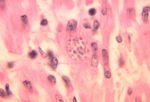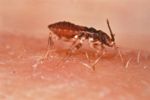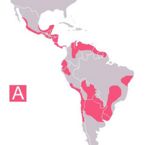Difference between revisions of "Trypanosoma"
Jump to navigation
Jump to search
| (20 intermediate revisions by 3 users not shown) | |||
| Line 1: | Line 1: | ||
| − | |||
| − | |||
| − | |||
| − | |||
| − | |||
| − | |||
| − | |||
| − | |||
| − | |||
| − | |||
| − | |||
| − | |||
| − | |||
| − | |||
| − | |||
| − | |||
| − | |||
| − | |||
| − | |||
[[Image:Trypanosoma.jpg|thumb|right|150px|''Trypanosoma cruzi'' <br> CDC/Dr. Myron G. Schultz, WikiMedia Commons]] | [[Image:Trypanosoma.jpg|thumb|right|150px|''Trypanosoma cruzi'' <br> CDC/Dr. Myron G. Schultz, WikiMedia Commons]] | ||
[[Image:T.cruzi in monkey heart.jpg|thumb|right|150px|''T. cruzi'' in monkey heart <br> Dr. L.L. Moore Jr., WikiMedia Commons]] | [[Image:T.cruzi in monkey heart.jpg|thumb|right|150px|''T. cruzi'' in monkey heart <br> Dr. L.L. Moore Jr., WikiMedia Commons]] | ||
[[Image:Triatoma infestans.jpg|thumb|right|150px|''Triatoma infestans'' the Kissing bug - WHO Wikimedia Commons]] | [[Image:Triatoma infestans.jpg|thumb|right|150px|''Triatoma infestans'' the Kissing bug - WHO Wikimedia Commons]] | ||
[[Image:Chagas endemic zones 2005.jpg|thumb|right|150px|Chagas endemic zones 2005 - Wikimedia Commons]] | [[Image:Chagas endemic zones 2005.jpg|thumb|right|150px|Chagas endemic zones 2005 - Wikimedia Commons]] | ||
| − | + | *Protozoal parasites found in the blood and tissues of vertebrates | |
| − | |||
| − | + | *Worldwide distribution | |
| − | |||
| − | + | *Causes sleeping sickness in humans | |
| − | |||
| − | + | *Particularly seen in sub-Saharan Africa | |
| + | **Affects cattle production | ||
| + | **Causes Nagana (Wasting disease) | ||
| − | ''''' | + | *Divided into two groups depending on the mode of development in the insect vector |
| + | **'''Salivarian''' | ||
| + | ***Multiply in the foregut and proboscis | ||
| + | ***Transmitted via inoculation during feeding | ||
| + | ***Transmitted by [[Glossinidae|''Tsetse'' flies]] | ||
| + | ***Also known as '''anterior station development''' | ||
| + | **'''Stercorarian''' | ||
| + | ***Multiply in the hindgut | ||
| + | ***Infective form migrates to the [[Rectum - Anatomy & Physiology|rectum]] | ||
| + | ***Transmitted via contamination of wounds with insect faeces | ||
| + | ***Also known as '''posterior station development''' | ||
| − | ''T. | + | *All ''Trypansomes'' except for ''T. equiperdum'' have arthropod vectors |
| + | **''T. equiperdum'' is a venereally transmitted disease | ||
| − | + | *'''Non-cyclical''' transmission can also occur | |
| − | + | **Mechanical transmission | |
| + | **Transferred by interrupted feeding from one host to another | ||
| + | **Usually transmitted by [[Biting Flies|biting flies]], e.g. [[Tabanidae|''Tabanidae'']] and [[Stomoxys calcitrans|''Stomoxys'']] | ||
| − | + | '''Recognition''' | |
| + | *Elongated, spindle shaped protozoa | ||
| − | + | *Between 8 and 39 μm in length | |
| − | + | *Flagellate | |
| − | + | **Flagellum runs the length of the body attached to the pellicle which forms an undulating membrane | |
| − | + | *Kinetoplast present which contains the DNA of the single mitochondrion | |
| − | + | '''Life Cycle''' | |
| − | + | *Undergo morphological transformations in intermediate host before becoming infective for the next host | |
| − | + | *Blood-sucking [[Biting Flies|flies]] ingest trypanosomes whilst taking a blood meal from an infected animal | |
| − | + | **Trypanosomes multiply first in the gut of the [[Biting Flies|fly]] | |
| − | + | *Salivarian trypanosomes are transmitted by [[Glossinidae|Tsetse flies]] | |
| + | **Trypanosomes pass forward to the salivary glands where they transform into the infective stage | ||
| + | **Inoculated with saliva when [[Glossinidae|Tsetse fly]] next feeds on a host | ||
| − | + | *Stercorarian trypanosomes are transmitted by triatomid bugs, [[Tabanidae|tabanids]] and [[Melophagus ovinus|keds]] | |
| + | **Trypanosomes pass back to the rectum | ||
| + | **Next host is infected when skin wounds are contaminated with infected [[Insecta|insect]] faeces | ||
| − | |||
| − | |||
| − | |||
| − | |||
| − | == | + | ==Test yourself with the Protozoa Flashcards== |
| − | |||
| − | |||
| − | + | [[Protozoa_Flashcards#Tropical_Protozoa|Tropical Protozoa Flashcards]] | |
| + | [[Category:Tropical Protozoa]] | ||
| − | + | [[Category:To_Do_-_Steph]] | |
| − | |||
| − | |||
| − | |||
| − | |||
| − | |||
| − | |||
| − | |||
| − | |||
| − | |||
| − | |||
| − | |||
| − | |||
| − | |||
| − | |||
| − | |||
| − | |||
| − | |||
| − | |||
| − | |||
| − | |||
| − | [[Category: | ||
Revision as of 22:53, 5 June 2011
- Protozoal parasites found in the blood and tissues of vertebrates
- Worldwide distribution
- Causes sleeping sickness in humans
- Particularly seen in sub-Saharan Africa
- Affects cattle production
- Causes Nagana (Wasting disease)
- Divided into two groups depending on the mode of development in the insect vector
- Salivarian
- Multiply in the foregut and proboscis
- Transmitted via inoculation during feeding
- Transmitted by Tsetse flies
- Also known as anterior station development
- Stercorarian
- Multiply in the hindgut
- Infective form migrates to the rectum
- Transmitted via contamination of wounds with insect faeces
- Also known as posterior station development
- Salivarian
- All Trypansomes except for T. equiperdum have arthropod vectors
- T. equiperdum is a venereally transmitted disease
- Non-cyclical transmission can also occur
- Mechanical transmission
- Transferred by interrupted feeding from one host to another
- Usually transmitted by biting flies, e.g. Tabanidae and Stomoxys
Recognition
- Elongated, spindle shaped protozoa
- Between 8 and 39 μm in length
- Flagellate
- Flagellum runs the length of the body attached to the pellicle which forms an undulating membrane
- Kinetoplast present which contains the DNA of the single mitochondrion
Life Cycle
- Undergo morphological transformations in intermediate host before becoming infective for the next host
- Blood-sucking flies ingest trypanosomes whilst taking a blood meal from an infected animal
- Trypanosomes multiply first in the gut of the fly
- Salivarian trypanosomes are transmitted by Tsetse flies
- Trypanosomes pass forward to the salivary glands where they transform into the infective stage
- Inoculated with saliva when Tsetse fly next feeds on a host
- Stercorarian trypanosomes are transmitted by triatomid bugs, tabanids and keds
- Trypanosomes pass back to the rectum
- Next host is infected when skin wounds are contaminated with infected insect faeces



